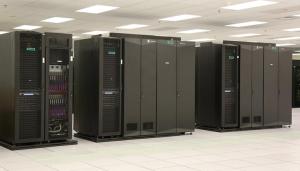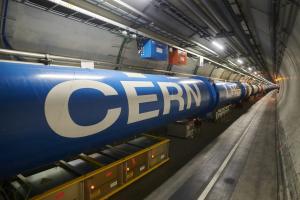LAB REPORT
Science and Technology Making Headlines
June 3, 2022


Three testbed machines for Lawrence Livermore National Laboratory’s future exascale El Capitan supercomputer all ranked among the top 200 on the latest Top500 List of the world’s most powerful computers. Photo by Katrina Trujillo/LLNL.
New kid in town
The U.S. can now claim the mantle as the top dog of supercomputers in the Top500 List of the world’s most powerful supercomputers.
Frontier, a new supercomputer developed by Oak Ridge National Laboratory became the first machine capable of demonstrating “exascale” performance, a highly coveted computing benchmark roughly equivalent to one quintillion operations per second. That mind-boggling number comes out to roughly a billion, billion calculations.
Frontier not only puts the U.S. ahead of other countries in terms of sheer supercomputer performance but does so with a sizable lead.
Three predecessor machines for Lawrence Livermore's future exascale system El Capitan managed to rank highly on the latest Top500 List of the world’s most powerful supercomputers.
Those three machines include some components that will eventually comprise El Capitan. El Capitan is expected to surpass two exaFLOPs after it is accepted at LLNL in 2023. With the addition of the new machines, LLNL now boasts nine systems on the bi-annual list, more than any other high performance computing center in the U.S.


A chain of magnets inside the tunnel at the Large Hadron Collider. Photo courtesy CERN.
Looking beyond the Standard Model
The bleeding edge of physics lies in a beam of subatomic particles, rushing in a circle very near the speed of light in an underground tunnel in Central Europe. That beam crashes into another racing just as fast in the other direction.The resulting collision produces a flurry of other particles, captured by detectors before they blink out of existence.
This is standard procedure at the Large Hadron Collider (LHC), which recently switched on for the first time since 2018, its beams now more powerful than ever. The LHC, located at the European Organization for Nuclear Research (CERN) near Geneva, is the world’s largest particle collider: a mammoth machine that literally smashes subatomic particles together and lets scientists watch the fountain of quantum debris that spews out.
Physicists have a good reason for the destruction. Inside those collisions, physicists can peel away the layers of our universe to see what makes it tick at the smallest scales.
But with every passing year, the Standard Model seems increasingly inadequate to answer basic questions. Why is there so much more matter in the universe than antimatter, its opposite? What makes up the massive chunk of our universe that seems to be unseen and unseeable? And why does gravity exist? The answers are anything but simple.
The answers may come in the form of yet-undiscovered particles. But, so far, they’ve eluded even the most powerful particle colliders. “We have not found any non-Standard Model particles at the LHC so far,” says Finn Rebassoo, a particle physicist at Lawrence Livermore National Laboratory in California and an LHC collaborator.


Satellite image of the Hunga volcano on Jan. 21, 2022. Image courtesy of the National Oceanic and Atmospheric Administration.
As big as it gets
The January 2022 eruption of the Hunga volcano in Tonga was the largest volcanic eruption in the 21st century, and the largest recorded since the 1991 eruption of Mount Pinatubo.
New research by an international team of scientists from 17 countries including Lawrence Livermore scientist Keehoon Kim demonstrates that, based on atmospheric pressure waves recorded by global barometers, the Hunga explosion was comparable to the 1883 Krakatoa eruption in size.
The atmospheric wave data shows that the eruption propagated for four passages around the Earth over six days. NASA determined that the eruption was “hundreds of times more powerful than the atomic bomb dropped on Hiroshima.”
The eruption began in December 2021 on Hunga Tonga–Hunga Ha’apai, a submarine volcano in the Tongan archipelago in the southern Pacific Ocean (submarine volcanoes are underwater vents or fissures in the Earth’s surface from which magma can erupt). The final eruption in January caused tsunamis in Tonga, Fiji, American Samoa, Vanuatu, and along the Pacific rim, including damaging tsunamis in New Zealand, Japan, the United States, the Russian Far East, Chile, and Peru.


LLNL researchers are working on technology to remove carbon dioxide that’s already been emitted.
A breath of fresh air in climate change
Carbon dioxide is a naturally occurring greenhouse gas, but human activity over the past century has sent atmospheric carbon dioxide levels skyrocketing. The result? Rising global temperatures and associated changes in climate patterns around the world.
For California, that means longer, more intense droughts, bigger heat waves and concerns over air quality. All those impacts can be traced back to carbon emissions. That's why there's a big push to move the state's economy toward more sources of green energy.
Climate experts say the state's current pace of slowing our current emissions down won't be enough. That's because carbon dioxide gas lingers in the atmosphere for thousands of years as more and more gets released.
"Once you put carbon dioxide into the air, it fundamentally stays there, on our lifetime scale forever," said Roger Aines, chief scientist with Lawrence Livermore National Laboratory.
Aines is leading a large team of scientists from various backgrounds who are looking for ways to not only reduce carbon emissions but to actively remove carbon dioxide that's already been emitted.


Researchers at LLNL and the University of California, Berkeley demonstrated the ability to 3D-print microscopic objects in silica glass through volumetric additive manufacturing. Image by Adam Lau/Berkeley Engineering.
Just a sec
Glass is increasingly being used in fiber optics, consumer electronics and microfluidics for “lab-on-a-chip” devices. Unfortunately, traditional glassmaking can be costly and slow, and 3D-printed small glass objects have rough surfaces, making them unsuitable for lenses.
To solve those problems, a research team from Lawrence Livermore and the University of California, Berkeley have devised a new method of 3D printing known as volumetric additive manufacturing (VAM). The team used VAM to print microscopic, delicate, layer-less silica-glass objects in silica glass parts in only seconds or minutes.
VAM is based on computed axial lithography (CAL), a technology based on computed tomography, a medical imaging tool. CAL computes projections from many angles on a model of the part being made. It then uses the best set of projections to guide LED light into a rotating a vat of photosensitive resin. Over time, the light beams establish a 3D light distribution in the resin, hardening it while the vat spins. The fully formed object materializes in mere seconds, far quicker than traditional layer-by-layer 3D printing. The vat is emptied to get the part.





